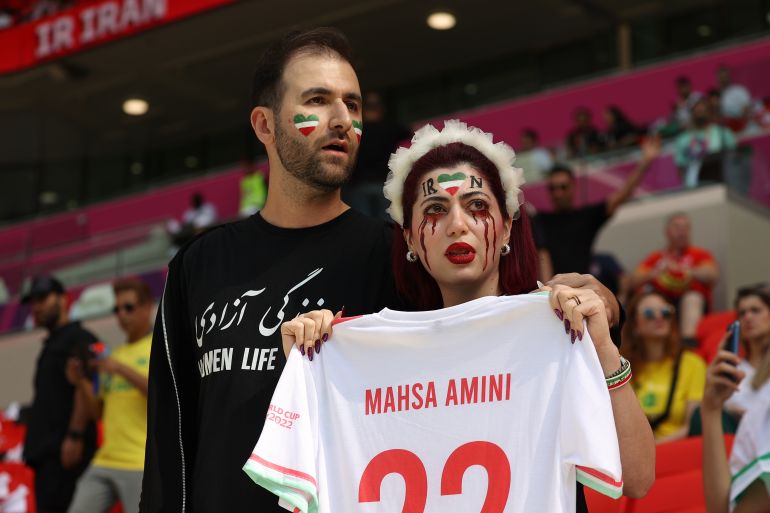EXPLAINER
Why are some of Iran’s fans protesting at the World Cup?
Iran’s presence at the World Cup has brought more attention to the country where anti-government protests continue.

Published On 25 Nov 2022
Tehran, Iran – After more than 10 weeks, protests in Iran are showing no imminent signs of dying down. Iran’s presence at the World Cup in Qatar, and the expressions of protest that have come with it, have focused more attention on the unrest within the country. Here’s what you need to know:
What’s been happening with Iran’s fans at the World Cup?
- Iran’s participation at the World Cup has caused controversy in some quarters, with Ukraine requesting they be disqualified for supplying Russia with armoured drones that have been used in Ukraine.
- Anti-government Iranians have taken the opportunity of Iran being on the international stage at the World Cup to demonstrate against the government, and raise awareness of the protests going on inside the country.
- Some have carried shirts carrying the name of a woman whose death in the custody of Iran’s morality police sparked the protests, while others have waved a flag that was used in Iran prior to the country’s 1979 Islamic Revolution.
- In Iran’s first game against England on Monday, Iran’s players did not sing the national anthem, in what was seen as a demonstration of support for the protests. In their second game against Wales on Friday, however, they did sing, albeit in a reserved manner. Iran’s coach Carlos Queiroz has complained about the attention being placed on Iran’s team.
- Pro-government and anti-government fans were both present in the game against Wales, with several instances reported of fans shouting and filming each other.
How did it all start?
- More than two months ago, Mahsa Amini, a 22-year-old woman from the city of Saqqez in Kurdistan, was in Tehran with family members when she was arrested by the country’s morality police for allegedly not adhering to Iran’s dress code for women.
- Videos released by the police showed she collapsed in a “re-education” centre, and she died in a hospital on September 16 after being in a coma for three days. Her family suspected she had been beaten. A state investigation reported no signs of beating and blamed her death on pre-existing conditions.
- Protests began the next day in Amini’s hometown and quickly spread to other cities across the country. They have since ebbed and flowed in different parts of Iran but have overall persisted amid severe internet restrictions that have been imposed since the first few days of unrest.
- Thousands of videos and images have been published online, many of them showing Iranians chanting anti-establishment slogans, with women taking off or burning their head coverings. Videos have also documented strikes in numerous cities.
What’s the latest?
- During the past week, the protests have been most intense in the northwestern parts of Iran, where Kurdish-majority provinces are located.
- Videos have widely circulated online from several cities, including Javanrud in Kermanshah, and Mahabad, Bukan and Piranshahr in West Azerbaijan, showing Iranian forces deploying heavily armoured vehicles and special forces.
- In Tehran and several other cities, videos showed sporadic protests after Iran’s match against England on Monday. Internet connections severely slowed across mobile and landline, according to local media and the NetBlocks observatory.
- Foreign-based human rights organisations have said dozens have been killed by security forces in the past two weeks, and they put the overall death toll since September at more than 400, including about 60 children, while saying thousands have been arrested.
- CNN on Tuesday released an investigative report saying Iranian security forces have sexually assaulted protesters, something Iranian authorities have yet to address.
What does the state say?
- Top Iranian officials, including Supreme Leader Ali Hosseini Khamenei, have repeatedly blamed the United States, Israel, the United Kingdom, France, Germany and Saudi Arabia for being behind the country’s unrest, which they have often described as “riots”.
- The authorities have not released official tallies about how many have been killed during the protests, but regularly publicise deaths among security forces, which according to them, number more than 50.
- At least six protesters have received preliminary execution sentences, according to the judiciary, which said on Tuesday at least 2,400 preliminary sentences of unspecified punishments have been issued across the country. The judiciary also said that 40 foreign nationals had been arrested during “riots” since September.
- The Islamic Revolutionary Guard Corps (IRGC) confirmed on Sunday it was “strengthening” its forces in the country’s northwestern regions, in what it said is a response to activities by “armed thugs and separatist terrorists”.
- Since September, the force has also carried several rounds of artillery, missile and drone attacks on positions in the northern region of neighbouring Iraq that it says are held by Kurdish groups that Tehran considers to be “terrorist” organisations. The latest attack came on Sunday.
What’s the reaction outside Iran?
- The US, the European Union, the UK and Canada have since September imposed a slew of human rights sanctions against Iranian officials and entities, which Tehran has responded to with sanctions of its own.
- After a formal request by Germany and Iceland, a special session of the United Nations Human Rights Council was held on Thursday to discuss the situation in Iran in light of the protests, amid Tehran’s objections. The council voted to establish a fact-finding mission to investigate potential abuses committed during the crackdown on the protests.
- A group of UN experts has also called on Iran to stop indicting people with charges punishable by death for participating in the protests.
- Iranians outside the country have held large rallies in cities across the world.
Source: Al Jazeera